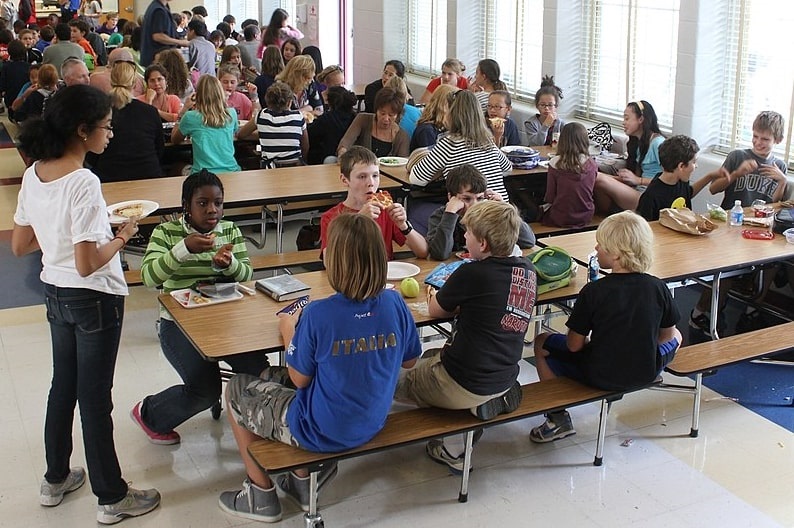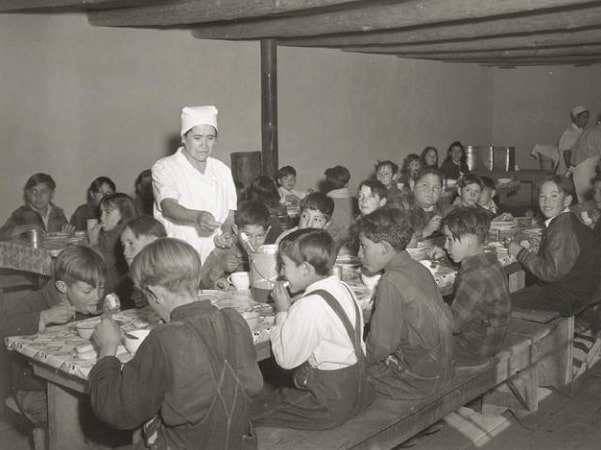Introduction: In this article – with students returning to school this week – Gena Philibert-Ortega suggests adding social history to your genealogy research by reading newspaper articles about school lunches. Gena is a genealogist and author of the book “From the Family Kitchen.”
It’s back to school time and one thought on your student’s mind is: “What’s for lunch?” Growing up, I envied those who got to eat lunch at the school cafeteria. For a child who rarely ate out, the school cafeteria meals provided the promise of an unfamiliar meal that was much more exciting than the standard sandwich, chips, and apple I saw in my lunch box day after day.
By the time I reached middle school, a rare treat was a few dollars to spend at the snack bar, allowing me to indulge in all the junk food I wanted. By high school, our “open campus” policy allowed us to walk to neighboring restaurants. With a job and my regular pay check I was able to eat whatever I wanted.

Since the beginning of compulsory education, kids have either walked home or brought something to eat to school. The hard times of the early 20th century made it obvious that not all families had the means to provide a lunch for their children. Reformers implemented programs to feed school children, and in 1946 President Truman signed the first National School Lunch Program bill, which has been amended over time.*
The topic of school lunches is a more complex one than what can be explored in a blog article – but for now, let’s concentrate on what schools have offered in relation to food for their students.
School Lunch Menus in Newspapers
For those 20th century families who could afford to send their children to school with a lunch or pay for a hot lunch at school, school menus in local community newspapers provided an opportunity for families to choose what days they were going to purchase or take their lunch. It also gave kids the opportunity to see what meals they could look forward to. (Anyone look forward to pizza day as a kid?) Not all newspapers published the local school menu, but those that did provide researchers with a social history look at their family member’s school life.
Obviously, school menus will reflect the time period and what foods were popular (and familiar) to the majority of the local kids. Take for instance this Milwaukee, Wisconsin, school menu for April 1968. Tuna Noodle Potato Chip Bake (most likely tuna casserole) was one of the offerings. Turkey Brazil on white rice is a dish I’m not familiar with but may be something popular for that time and place. Each meal at the school was accompanied with an individual carton of milk.
This 1951 Dallas, Texas, school lunch menu states that the lunches are “a selection of foods youngsters like.” In the case of these school lunches, elementary kids would have paid 18 cents and middle and high school students, 23 cents. One of the regional foods featured in the week’s menu was Tamale Pie.
When I am looking over these newspaper school menus, I find that some of the older ones include foods I would eat now. Here’s one from 1950 printed in the Springfield Union that includes deviled eggs. Though some of the foods offered are not my favorites, they were inexpensive and could easily be made for a large crowd of school kids – such as the “creamed dried beef on toast” that you may know by a less appetizing name. This menu does include quite a few sandwiches, including this interesting one with peanuts and marshmallows.
Other Newspaper Articles Related to School Lunches
School lunch menus aren’t the only article about the subject to be found in historical newspapers. People’s opinions and the sharing of recipes were also topics of interest.
Over time it’s not unusual to find changes to the school menu – and complaints from parents and students about what makes an appropriate school lunch. For example, this 1922 Grand Rapids Press article states that boys like to eat like “real men” and prefer red meat and pies and doughnuts, in contrast to the women staff and girl students who prefer salads, cake, and “fancy fixings.” Because of that discrepancy, the boys have to patronize local stores during lunch to acquire food that “sustains life.”
I especially like this article from the 1931 cafeteria manager at Grant High School in Portland, Oregon, who claims to know exactly what the 950 students she feeds daily like. Surprisingly, or maybe not since it was the 1930s, they like to get a lot for their school lunch money – so the cafeteria “always offers soup of some kind, meat also, perhaps, in a hot sandwich, and a meat substitute as well. Potatoes, likewise, are included in each days’ bill of fare. There are salads, too, of both fruits and vegetables… Desserts may usually be chosen from puddings, pies and cake.”
When asked to provide a favorite recipe that was popular in the cafeteria, she provided one for Cheese and Corn Loaf. Once again, a dish that is specific to the era that it was served in.
What Did You Have for Lunch?
Telling our personal life stories is a part of family history. Sharing stories of your school days by discussing friends, teachers, favorite subjects, activities, and even what you ate will be of interest to your descendants.
Did you eat in the school cafeteria? What were your favorite meals? Is there anything you ate then that is a regular meal in your life today? Any special memories? Please share them with your family and us in the comments below.
* “National School Lunch Program,” US Department of Agriculture (https://www.fns.usda.gov/nslp: accessed 15 August 2022).
Note: An online collection of newspapers, such as GenealogyBank’s Historical Newspaper Archives, is not only a great way to learn about the lives of your ancestors – the old newspaper articles also help you understand American history and the times your ancestors lived in, and the news they talked about and read in their local papers.
Note on the header image: a photo of schoolchildren eating hot school lunches made up primarily of food from the surplus commodities program. Taken at a school in Penasco, New Mexico, December 1941. Credit: United States Department of Agriculture; Wikimedia Commons.
